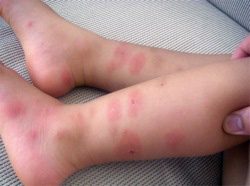
Bed bug bites are usually characterized by red marks, bumps, and welts like the ones displayed above. It is important to have a bed bugs overview to understand their habits better.
Bed bugs are small in stature, and this gives them an advantage as they can move easily without detection. They take refuge in cool dark places. They are nocturnal insects that means they can mainly feed at night when humans are at sleep. While bed bugs prefer night if the infestation is severe, they also may be seen during daytime hours.
It is important to know where bed bugs typically hide to be aware of where to look for them. Bed bugs usually hide in places like box springs, headboards, cracks, crevices, mattresses, couches and so on. They prefer crevices during daylight hours, so they have a secure spot to hide.
When bed bug feed, it can be a bit difficult to notice them, this is because they inject an anticoagulant that prevents you from feeling any pain. Itching usually comes in the morning after the bites. If you move suddenly in your sleep the bed bug will withdraw its beak and when you stop moving the bed bug will resume trying to feed.
If you suspect, you have a bed bug infestation it is important that you pay attention to your surroundings and look for common signs that indicate the presence of bed bugs. Common signs include fecal stains, eggs, dark spots, empty skins, and exoskeleton. Bed bug eggs are white and translucent and can be difficult to spot. This bed bugs overview should help answer common questions.



